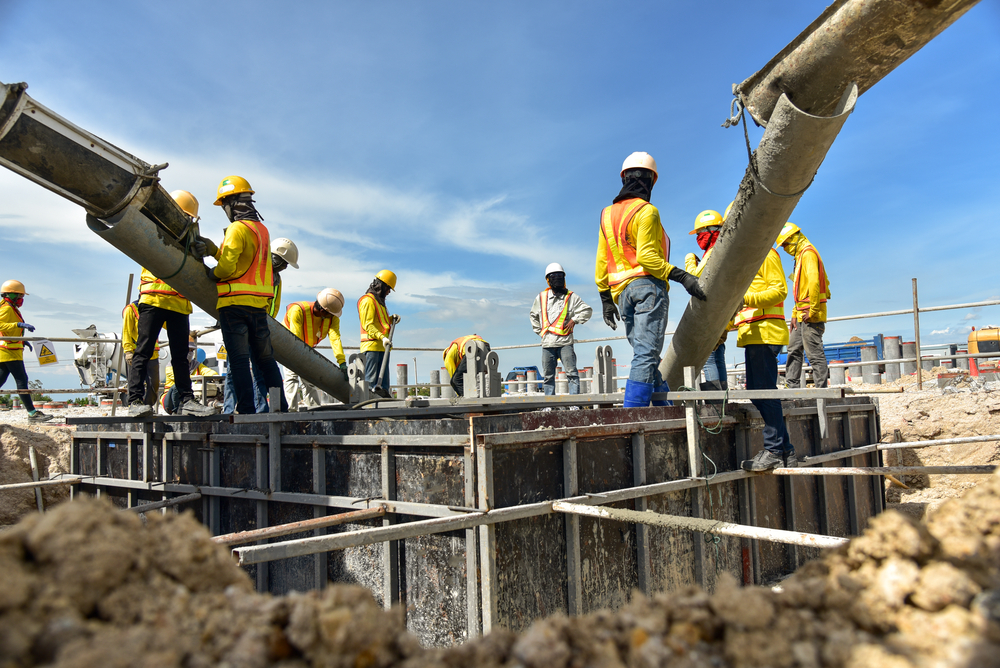In the ever-evolving and dynamic world of construction, understanding and adapting to the industry’s cyclical nature is paramount for sustained success and growth. As we edge closer to the anticipated busy season, the role of effective construction recruitment strategies becomes increasingly crucial. The ability to proactively navigate construction recruitment not only ensures that projects are delivered on time and to the highest standards but also fosters long-term growth and stability within firms.
This blog post is designed to guide construction firms through the complexities of recruiting in preparation for the busy season. We will delve into the latest construction trends for 2024, highlighting how these developments impact recruitment practices. Furthermore, we’ll explore the significance of transparency in the construction recruitment process and discuss the invaluable benefits of investing in training and development for your workforce.
As the construction landscape continues to evolve, being equipped with knowledge and the right strategies for construction recruitment can set your projects—and your company—apart from the competition.
Understanding the Construction Industry’s Busy Season
The busy season in the construction industry is a period characterized by a significant uptick in activity and projects. This season is not merely a time of increased workload but a critical phase that can define the success and profitability of construction firms for the entire year. Understanding what constitutes the busy season, why it occurs, and how it impacts staffing and project planning is essential for any construction firm aiming to thrive.
What Constitutes the Busy Season
The busy season is often dictated by several factors, most notably weather conditions. In many regions, warmer and drier months offer the ideal conditions for construction work, leading to a surge in projects. However, the busy season can also be influenced by economic trends, such as increases in funding for public infrastructure projects or a rise in demand for residential and commercial buildings. Industry-specific cycles, such as seasonal demand for certain types of construction work, also play a crucial role.
Factors Contributing to the Increased Workload
The busy season in construction sees a spike in workload due to better weather, economic growth, and industry cycles. Favorable weather speeds up projects, economic upturns increase demand across public and private sectors, and certain times of the year boost activity in areas like residential and infrastructure development.
Impact on Staffing Needs and Project Planning
The busy season significantly impacts staffing needs and project planning. The surge in projects demands a larger workforce, necessitating effective construction recruitment strategies to secure skilled labor. Firms must anticipate these staffing needs well in advance to ensure they have the necessary workforce to meet project deadlines and maintain quality standards. Failure to adequately prepare for this increased demand can result in project delays, increased costs, and missed opportunities.
In summary, the busy season in the construction industry presents both opportunities and challenges. By understanding its dynamics and preparing through strategic construction recruitment, firms can ensure they not only survive but thrive during these peak periods. The following sections will further explore how to navigate construction recruitment effectively, focusing on emerging trends, the importance of transparency, and the value of investing in your workforce’s development.
Construction Trends for 2024

As we look ahead to 2024, several emerging trends within the construction industry are set to shape both project management and construction recruitment strategies significantly. From technological advancements and sustainability practices to shifts in project types, these trends for 2024 are not only reshaping the landscape of construction but also the workforce skills and specialties in high demand.
Technological Advancements
The construction industry continues to embrace technology, with digital tools and solutions becoming more integral to project planning, execution, and management. Technologies such as Building Information Modeling (BIM), drones, and augmented reality (AR) for site surveys and inspections are streamlining operations and enhancing precision. Consequently, there’s an increasing demand for tech-savvy professionals in construction recruitment, with skills in managing and operating these advanced tools.
Sustainability Practices Trends in 2024
Sustainability is moving from a niche concern to a central factor in construction projects. As regulations tighten and environmental awareness grows, there is a rising demand for green building materials, energy-efficient designs, and construction methods that minimize environmental impact. This shift requires construction recruitment to focus on professionals with expertise in sustainable construction practices, renewable energy integration, and green certifications.
Shifts in Project Types
The construction industry is seeing a diversification in project types, with an equal focus on both public and private sectors. Infrastructure projects are gaining momentum, driven by governmental investments, while residential and commercial construction continues to grow, reflecting economic trends and societal needs. This diversification necessitates a workforce adept in a variety of construction disciplines, emphasizing the need for versatile skills in construction recruitment.
Addressing the Skilled Worker Shortage
The construction industry is grappling with a significant skilled worker shortage, a situation that is expected to worsen in 2024. It was estimated that over 546,000 additional workers would be needed beyond normal hiring practices to meet the labor demands in 2023, a trend that will continue into the next year (Associated Builders and Contractors, 2023). This shortage underscores the critical importance of construction recruitment strategies aimed at attracting and retaining skilled professionals.
Increased Subcontractor Default
Subcontractors are facing substantial financial pressures, having shouldered additional costs totaling over $97 billion in the past year (CURT, 2023). This financial strain has led to cash flow problems, making subcontractor default a significant concern across the industry. Effective construction recruitment and project management strategies must include risk assessment and mitigation plans for subcontractor defaults.
Rising Costs Due to Higher Interest Rates
The industry is also contending with cost inflation driven by higher interest rates. Increased financing costs have pushed up the prices of construction materials and labor, with approximately 82.5% of construction materials experiencing price hikes averaging around 19% since 2020 (Construction Dive, 2023). This inflationary pressure makes budget management and cost-effective construction recruitment more crucial than ever.
Increasing Safety Measures
There’s a growing emphasis on safety measures within the industry, driven by both regulatory requirements and a genuine commitment to worker well-being. This trend is influencing construction recruitment, with a premium placed on professionals who prioritize safety and are knowledgeable in the latest safety standards and practices.
Embracing Diversification
Finally, the industry’s move towards diversifying project types, encompassing both public and private sectors, requires a multifaceted approach to construction recruitment. Firms must seek out professionals who are not only skilled in specific construction methods but also adaptable to the varying demands and challenges presented by different types of projects.
In conclusion, the construction trends for 2024 highlight the need for a proactive and strategic approach to construction recruitment. By understanding these trends and their impact on the demand for specific skills and specialties, firms can better prepare to meet the challenges of the coming year, ensuring project success and industry growth.
Challenges in Construction Recruitment

The realm of construction recruitment is fraught with challenges, particularly as firms gear up for the busy season. The success of construction projects hinges not only on the quality of materials and designs but critically on the talent behind the work. As the demand for skilled labor intensifies, construction firms face several obstacles.
Finding Skilled Labor
One of the most significant hurdles in construction recruitment is the acute shortage of skilled labor. As we previously stated, an estimated half a million workers are needed to balance supply and demand. The construction industry is experiencing a generational shift, with a noticeable gap left by retiring professionals. Attracting new talent while competing with other sectors for skilled workers poses a significant challenge.
Competitive Hiring Landscape
The construction industry is not alone in its quest for skilled professionals; thus, the hiring landscape has become increasingly competitive. Construction firms must differentiate themselves to attract and retain the best talent, making construction recruitment a strategic priority. Offering competitive wages, benefits, and opportunities for growth are vital in standing out.
Time Constraints and the Urgency to Fill Positions
The cyclical nature of the construction industry often leads to tight timelines for project completion. This urgency is compounded during the busy season, placing added pressure on construction recruitment efforts. The need to quickly fill positions can sometimes lead to compromises on the quality of hires if not managed carefully.
Impact on Project Timelines and Quality
Failing to address these construction recruitment challenges can have dire consequences on project timelines and overall quality. Delays in filling key positions can lead to project setbacks, while hiring underqualified personnel can affect the quality of work and safety on site. Therefore, addressing these challenges proactively is crucial for the success of construction projects.
Strategic Recruitment Planning

To navigate the tumultuous waters of construction recruitment, strategic planning is essential. A well-thought-out recruitment strategy can be the difference between project success and failure, especially during the busy season.
Importance of Early and Strategic Planning in Recruitment
Early and strategic planning in construction recruitment allows firms to anticipate staffing needs, reducing the rush and potential compromises associated with last-minute hiring. This proactive approach ensures that the right talent is in place when projects commence, aligning workforce capabilities with project requirements.
Forecasting Staffing Needs
Effective construction recruitment begins with accurate forecasting of staffing needs. Firms should analyze upcoming projects, considering their scope and complexity, to determine the types and numbers of professionals required. Historical data on workforce performance and project outcomes can provide invaluable insights for this forecasting process.
Building a Talent Pipeline
A key component of strategic construction recruitment is the development of a talent pipeline. Identifying and engaging with potential candidates before the need arises ensures a reservoir of qualified individuals ready to step into roles as they become available. This approach can involve outreach efforts, such as participating in job fairs, collaborating with educational institutions, and leveraging social media and professional networks to showcase the company and attract prospective employees.
By addressing the challenges in construction recruitment through strategic planning and proactive efforts, firms can position themselves for success. Building a robust talent pipeline and forecasting staffing needs with precision ensures that projects have the skilled workforce required to meet the demands of the busy season, maintaining project timelines and quality standards.
To overcome the hurdles of construction recruitment and secure top talent in a competitive market, firms need to employ effective and innovative recruitment techniques. These strategies not only widen the talent pool but also ensure the attraction and engagement of candidates who can drive success in the construction industry.
Leveraging Online Job Platforms and Social Media
The digital age has transformed how companies approach recruitment, with online job platforms and social media playing pivotal roles. For construction recruitment, leveraging these platforms allows firms to reach a broader audience, including passive candidates who might not be actively searching for a job but are open to the right opportunities. Social media, in particular, offers a way to showcase company culture and high-profile projects, making your firm more attractive to prospective employees.
Networking and Relationship-Building
Despite the advancements in technology, traditional networking remains a cornerstone of effective recruitment. Building and maintaining relationships within the construction industry can lead to valuable referrals and insights into the availability of skilled professionals. Industry events, seminars, and professional associations provide excellent opportunities for networking and raising your company’s profile among potential candidates.
Offering Competitive Wages and Benefits for Construction Trends in 2024
To attract top talent in the construction industry, offering competitive wages and benefits is essential. However, beyond just the numbers, emphasizing pay and job requirement transparency can significantly enhance your firm’s attractiveness as an employer. Clear communication about compensation, job roles, and career advancement opportunities can set your firm apart in a competitive recruitment landscape.
Rising average wage rates in construction underscore the importance of offering competitive compensation to attract and retain talent. BLS data reveals that average hourly wages climbed by 5.2% year over year to US$36.70 in August 2023, marking a 17% increase since March 2020, with expectations of continued upward pressure into 2024 as labor demand surpasses supply (Bureau of Labor Statistics, 2023). This trend emphasizes the competitive advantage larger firms have in attracting talent through higher salaries, impacting smaller firms more significantly. Moreover, many Engineering & Construction (E&C) firms have responded by enhancing base pay, bonuses, incentives, and employee benefits over the last 12 months to appeal to a broader talent pool (Engineering & Construction Industry Survey, 2023), highlighting how competitive wages and benefits are vital for recruitment in an industry facing tight labor markets and potential challenges in project execution and profit margins.
Implementing an Employee Referral Program
Employee referral programs are a powerful tool in construction recruitment, tapping into the existing networks of your workforce. Such programs not only expedite the recruitment process but often lead to hires who are a better fit and more engaged, having been referred by current employees who understand your company’s culture and expectations.
Partnering with Educational Institutions and Training Programs

Forming partnerships with educational institutions and training programs can provide a direct line to emerging talent in the construction industry. These partnerships can take various forms, from offering internships and apprenticeships to participating in career fairs and guest lecturing opportunities. Such initiatives not only help in filling immediate staffing needs but also in building a long-term talent pipeline.
Embracing Technology in Recruitment
Technology plays a transformative role in modern recruitment strategies, making processes more efficient and appealing to a tech-savvy generation of construction professionals.
In the construction sector, leveraging technology in recruitment is becoming a game-changer, mirroring advancements seen in other industries. Automation and artificial intelligence (AI) play critical roles in refining the recruitment process, offering unprecedented efficiencies and insights. By adopting Applicant Tracking Systems (ATS) and advanced communication tools, construction firms can significantly reduce the manual labor associated with traditional hiring practices. These technologies automate tasks like posting job listings, filtering applications, and managing candidate communications, thereby streamlining the administrative side of recruitment.
The impact of AI and machine learning in construction recruitment is profound. AI excels in automating the initial phases of candidate screening, utilizing chatbots for immediate communication, and predicting the likelihood of a candidate’s success in a given role. This technology enables firms to focus their human resources on more strategic aspects of hiring. AI’s analytical power shines in parsing through vast amounts of data from resumes and job descriptions to identify candidates who not only have the required technical skills but also align with the company’s culture and project needs.
Furthermore, AI-driven tools enhance the matching process, assessing candidates beyond their technical capabilities to include their potential cultural fit and long-term success within the company. This nuanced approach to candidate evaluation allows construction firms to make more informed hiring decisions, significantly improving the quality of new hires and contributing to the company’s growth.
By embracing automation and AI, construction firms can navigate the complexities of today’s labor market more effectively. These technologies enable faster filling of positions with highly qualified candidates, ensuring that construction projects have the skilled professionals needed to meet deadlines and quality standards. The integration of these advanced technologies into construction recruitment marks a shift towards more strategic, efficient, and successful hiring efforts, setting a new standard in the industry.
Investing in Training and Development
A cornerstone of successful construction recruitment lies in the commitment to training and development for both new hires and existing employees. The dynamic nature of the construction industry, especially with the emergence of 2024 trends such as technological advancements and sustainability practices, necessitates a workforce that is not only skilled but also adaptable and forward-thinking.
Providing training and development opportunities tailored to meet these evolving needs can significantly enhance your firm’s attractiveness to prospective employees. It signals a commitment to employee growth and career advancement, making your company a desirable place to work. Moreover, investing in the continuous development of your workforce ensures that your team remains at the cutting edge of industry standards and practices, directly contributing to improved project outcomes and higher retention rates.
Retention Strategies for the Busy Season and Beyond
Effective retention strategies are crucial for maintaining a stable and skilled workforce, particularly during the busy season and beyond. Implementing comprehensive onboarding programs that acclimate new hires to the demands of the busy season can set the tone for a successful tenure at your company. These programs should go beyond basic job training to include introductions to your company culture, values, and long-term vision.
Further reinforcing your commitment to training and development, offering ongoing employee development and career advancement opportunities can significantly impact your retention rates. Employees are more likely to stay with a company that invests in their growth and offers clear paths to advancement.
Creating a positive workplace culture and team environment is another key element. This includes transparency in pay and job expectations, which fosters trust and satisfaction among your workforce. A culture that values and supports its employees is essential for retaining top talent and ensuring the long-term success of your construction projects.
Wrapping Up Construction Trends for 2024
Throughout this discussion on construction recruitment, the underlying theme has been the critical nature of preparation and strategic action in anticipation of 2024’s construction trends. From leveraging advanced recruitment technologies to fostering a culture of growth and development, the strategies outlined here are designed to position firms for success in an increasingly competitive landscape. The call to adapt to industry changes and embrace these recruitment and retention strategies is not just advice—it’s a necessity for firms aiming to thrive. As we look to the future, the early initiation of these processes, coupled with a transparent and developmental approach to workforce management, will be key to navigating the challenges ahead. We encourage firms to not only take these insights on board but also to explore further by requesting a demo from Gotoro, where innovative solutions meet construction recruitment needs.


